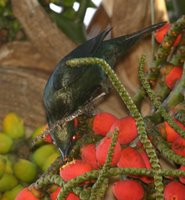How birds handle the larger ceram palm fruits
 In an earlier posting it was mentioned that Asian Glossy Starlings (Aplonis panayensis) swallowed the fruits of Alexandra palm (Archontophoenix alexandrae) and a little while later regurgitated the large seeds. In subsequent observations I noticed that other starlings did not always swallow the fruits followed by regurgitating the seeds. They just pecked at the thin pulp surrounding the seeds, leaving the fruits on the inflorescence branch with patches of skin removed. It may be possible that when the fruits are ripe and the pulp soft, the birds will swallow the fruits whole. Short of conducting experiments with caged birds, we may not know when the birds swallow and when they just peck at the pulp.
In an earlier posting it was mentioned that Asian Glossy Starlings (Aplonis panayensis) swallowed the fruits of Alexandra palm (Archontophoenix alexandrae) and a little while later regurgitated the large seeds. In subsequent observations I noticed that other starlings did not always swallow the fruits followed by regurgitating the seeds. They just pecked at the thin pulp surrounding the seeds, leaving the fruits on the inflorescence branch with patches of skin removed. It may be possible that when the fruits are ripe and the pulp soft, the birds will swallow the fruits whole. Short of conducting experiments with caged birds, we may not know when the birds swallow and when they just peck at the pulp.
The fruits of my ceram palms (Rhopaloblaste ceramica) are now ripening and I had the opportunity to observe a flock of starlings feasting on the fruits. These fruits are larger than the Alexandra palm, each about 35 x 20 mm as opposed to 12 x 10 mm fruits of the latter. The pulp of both seeds is thin, less than 2 mm thick. For a bird the size of the starling, it is understandable that it merely pecks off pieces of the pulp.

 Yellow-vented Bulbul (Pycnonotus goiavier), about the size of a starling, similarly pecks on the pulp of ripe ceram fruits, without dislodging them from their inflorescence branch. Another bird that had been observed eating these fruits was the blue-crowned hanging parrot (Loriculus galgulus). As with the other birds mentioned earlier, it merely bit off pieces of the pulp.
Yellow-vented Bulbul (Pycnonotus goiavier), about the size of a starling, similarly pecks on the pulp of ripe ceram fruits, without dislodging them from their inflorescence branch. Another bird that had been observed eating these fruits was the blue-crowned hanging parrot (Loriculus galgulus). As with the other birds mentioned earlier, it merely bit off pieces of the pulp.Along my driveway below these ceram palms, I find seeds of the Alexandra and MacArthur palms (Ptychosperma macarthurii) totally devoid of the pulp. Obviously they have been regurgitated by birds that also feed on the ceram fruits. I know that the starling regurgitate the former seeds but I have no proof that any bird regurgitates seeds of the latter. Can it also be the starling? It would be interesting to find out!
Asian Koel (Eudynamys scolopacea) is reputed to be able to swallow seeds larger that 18 mm diameter but I have yet to observe this bird eating these fruits that is 2 mm larger in diameter, besides being 35 mm long. No doubt it would be an interesting observation.
It should be noted that these birds do not assist in the dispersal of the seeds of this palm as they merely fall on the ground below the palm. As the palm is native to the Moluccas where it grows in the rainforest, its dispersal agent is probably not present in Singapore.
Note: scale in mm. Text and images by YC.
Labels: Feeding



2 Comments:
Hey YC, regarding the earlier post on the Great Hornbill roosting outside my window (entry March 18, 2006):
1) it arrives punctually every day to roost between 7-7.15pm, and starts its day at 6.45-7am, flying off in the direction of bkt timah hill.
2) I've never seen it with a mate. Far as I can see, he/she's a loner.
3) I haven't had a look at its droppings below, but you're welcome to come by and have a look round, or take a few pics/observe the hornbill - just email me at brian@bs.sg. I'm on leave this month so it's the best period if you/any birdwatching fans want to pop by.
4) I've recorded a 3min video of the Hornbill as it arrives in the evening - it's a large file but I'm trying to upload it now and will post it on my blog site soon.
And you can view the video i uploaded here:
http://video.google.com/videoplay?docid=-5898285817977522060&q=hornbill&pl=true
Post a Comment
<< Home